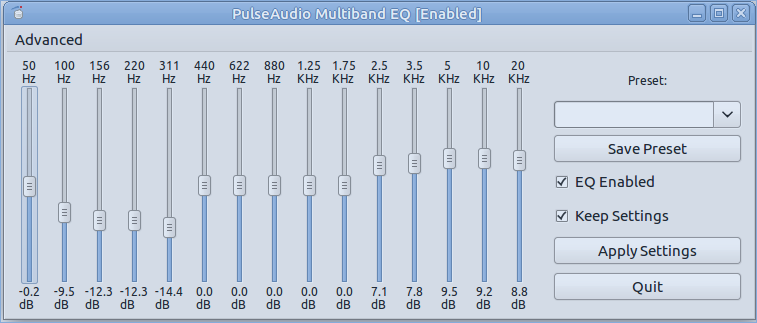
This means that we let go of automatic discovery and tell the client where the server is. Load-module module-tunnel-sink-new server= 192.168.0.1 sink_name=Remote channels=2 rate=44100 In /etc/pulse/default.pa I added (where 192.168.0.1 is the PulseAudio server): I had testing versions of Pulseaudio to achieve this (client needs to be version 5+, the server can be older), but since Debian stable is Jessie, everything is back to be being kosher (stable). It's now been more than a few months and everything is okay. On IRC a very nice human told me I could set up a tunnel from the client to the server. In some cases the above doesn't work so well, there may be some lag, the server might die, etc. Pulseaudio -start Sound Client 2 - using a tunnel really ? You could just kill and start your PulseAudio session thing: The easiest way is to reboot the whole system, but really. Then all is left is to restart PulseAudio on the client. Run paprefs and under the "Network Access" tab there should be an option called "Make discoverable PulseAudio network sound device available locally", activate that.

We need to change a PulseAudio client preference, and because this is a desktop I don't mind resorting to a GUI, so I installed paprefs: Sound ClientĪs usual I am using Debian, in this case Wheezy, hence maybe a standard Squeeze may not work with this (I haven't tested yet). You could either restart PulseAudio or just reboot the whole thing if you're lazy.

Tell PulseAudio to listen (lolpunhaha) to network connections by adding the following 2 lines to /etc/pulse/system.pa (adjust the subnet to whatever you need):

Then edit /etc/default/pulseaudio and change PULSEAUDIO_SYSTEM_START from 0 to 1:
Pulseaudio ubuntu install#
Then install a few new things:Īpt-get install pulseaudio pulseaudio-module-zeroconf avahi-daemon dbus-x11 I would say you should already have sound working on this computer. I am using a Raspberry Pi that I was offered by a friend (because I had gotten technically older) but I am sure this should work with any computer. About a decade ago, in the days of OSS I once even tried to export /dev/pcm using NFS. It may have taken me years, but finally I got around to implementing this and it works, easy.
Pulseaudio ubuntu update#
Update 2: I added a tunnel setup that I got from a helpful person on pulseaudio's IRC channel.
Pulseaudio ubuntu manual#
Then i restarted alsa and all work's, however in original manual tell's that for some receivers or tv's you need add another line if that fix won't work Add the following line to the end of /etc/asound.Update 1: I added the package dbus-x11 which needs to be manually installed for this to work on a system that has no X server. then i had put the line 0 0x04 into /etc/nf and it see like that

In my case my Sony receiver don't want to play sound so. To do so, add the following lines to the end of the /usr/share/pulseaudio/alsa-mixer/profile-sets/nf file: Ĭhannel-map = front-left,front-right,rear-left,rear-right,front-center,lfeĮither restart your computer or reload ALSA with the following: The ALSA plugin can be used with PulseAudio. (for ubuntu 18.04 change repository in /etc/apt//rebuntu16-ubuntu-avidemux_unofficial-bionic.list from "bionic" to "trusty", like: If you don't want compile dcaenc from git you can simply install it from repository add-apt-repository ppa:rebuntu16/avidemux+unofficial Warning though, do not run it twice since you'll end up inserting same stuff to nf and PulseAudio nf twice. The following script does the steps outlined in the rest of the document. This page will help you to output 5.1 DTS through Alsa, enabling Pulseaudio to use it.


 0 kommentar(er)
0 kommentar(er)
